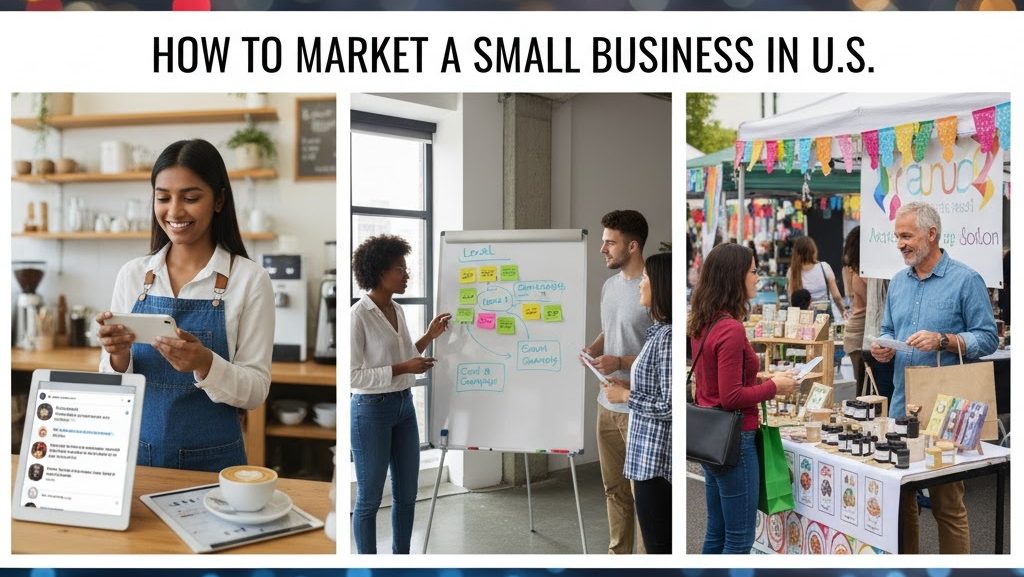Launching a small business in the United States is an exciting milestone — but sustaining it requires more than just passion and a good product. The key to success lies in strategic marketing. Whether you run a local café, an online boutique, or a consulting firm, knowing how to market your small business effectively can make the difference between slow growth and thriving success.
According to the U.S. Small Business Administration (SBA), over 33 million small businesses operate in America, making competition fierce. The good news? With the right marketing strategy, even small players can attract loyal customers, compete with big brands, and dominate their niche.
This guide will show you exactly how to market a small business in the U.S. using actionable, research-backed methods that are affordable and results-driven.
1. Understand Your Target Market
Before spending a dollar on advertising, you need to understand who you’re trying to reach. One of the biggest mistakes small business owners make is marketing to “everyone.” In reality, specific targeting produces better results and saves money.
How to Identify Your Target Audience
- Define demographics: Age, gender, income level, location, and occupation.
- Understand psychographics: Values, interests, and lifestyle choices.
- Study customer behavior: What motivates them to buy? What problems are they trying to solve?
A Harvard Business Review study found that companies using data-driven customer segmentation achieved up to 60% better ROI on marketing campaigns than those relying on assumptions.
Tools to Help:
| Tool | Purpose | Benefit |
|---|---|---|
| Google Analytics | Tracks visitor demographics | Understands audience behavior |
| Facebook Audience Insights | Analyzes social media demographics | Optimizes ads and engagement |
| SurveyMonkey | Gathers customer feedback | Identifies preferences and pain points |
Pro Tip: Create customer personas—fictional profiles that represent your ideal buyers. These help personalize your marketing campaigns and messaging.
2. Build a Strong Brand Identity
Branding isn’t just about having a logo or a catchy slogan—it’s about how your business makes people feel. Your brand is your identity, reputation, and promise to your customers.
Key Elements of Branding
- Logo: Simple, recognizable, and meaningful.
- Color Palette: Choose colors that reflect your brand personality.
- Tone of Voice: Decide whether your brand sounds professional, friendly, or bold.
- Mission Statement: Communicate what your business stands for.
A study by the University of Southern California Marshall School of Business found that consistent branding across all platforms increases revenue by up to 23%.
Actionable Branding Tips
- Use the same colors, fonts, and tone on your website, social media, and print materials.
- Develop a professional logo using affordable tools like Canva or hire a freelancer on Upwork.
- Craft a brand story that resonates with your audience emotionally.
3. Create a Professional Website
Your website is often the first impression potential customers get of your business. In 2025, over 85% of consumers research online before making a purchase, according to Pew Research Center.
Must-Have Website Features
- Mobile-friendly design (responsive layout for smartphones and tablets)
- Fast loading speed (under 3 seconds)
- Clear navigation and call-to-action buttons
- SEO-optimized content with relevant keywords
- Contact page with phone, email, and address
Best Platforms for Small Business Websites
| Platform | Ideal For | Cost Range | Notes |
|---|---|---|---|
| WordPress | Flexibility and SEO | Free–$25/month | Great for blogs and e-commerce |
| Wix | Ease of use | $10–$29/month | Drag-and-drop builder |
| Shopify | Online stores | $29–$79/month | Best for e-commerce |
| Squarespace | Portfolios & services | $12–$26/month | Beautiful design templates |
SEO Tip: Include location-based keywords such as “affordable catering service in Los Angeles” to attract nearby customers.
4. Invest in Local SEO
If you run a small business that serves a specific community, local SEO (Search Engine Optimization) can help you appear in Google’s “near me” searches and local map listings.
Local SEO Checklist
-
Claim and optimize your Google Business Profile.
-
Add your NAP (Name, Address, Phone Number) consistently across all directories.
-
Encourage Google reviews from happy customers.
-
Use local keywords like “best plumber in Dallas” or “New York dog grooming services.”
According to a BrightLocal 2024 survey, 76% of local mobile searches result in a store visit within 24 hours — a strong indicator of local SEO’s power.
Pro Tip:
Post regularly on your Google Business Profile, share photos, and respond to reviews. These activities help boost local visibility and trust.
5. Leverage Social Media Marketing
Social media is a goldmine for small businesses — offering free visibility, engagement, and direct communication with customers.
Top Platforms for Small Business Marketing
| Platform | Audience Type | Best For |
|---|---|---|
| Broad audience | Local promotions, ads | |
| Visual storytelling | Fashion, food, lifestyle | |
| TikTok | Younger audience | Viral videos, product demos |
| Professionals | B2B marketing, networking | |
| X (formerly Twitter) | Quick updates | News, service alerts |
A study from New York University’s Stern School of Business revealed that small businesses using social media actively experienced up to 30% faster growth than those that didn’t.
Actionable Strategies
- Post consistently (3–5 times per week).
- Engage with followers by responding to comments.
- Use hashtags relevant to your niche.
- Collaborate with local influencers or micro-influencers.
Pro Tip: Short-form videos (under 60 seconds) perform best across platforms like TikTok, Instagram Reels, and YouTube Shorts.
6. Email Marketing: Build Long-Term Relationships
Email remains one of the most cost-effective tools for small business marketing. For every $1 spent, email marketing yields an average ROI of $42, according to DMA (Data & Marketing Association).
How to Get Started
- Collect emails through website sign-ups, lead magnets, or events.
- Segment your email list (e.g., new customers, loyal clients, inactive users).
- Send personalized and valuable content.
Types of Email Campaigns
- Welcome emails: Introduce your brand.
- Promotional offers: Highlight discounts or new products.
- Newsletters: Share updates and industry insights.
- Re-engagement emails: Win back inactive subscribers.
Best Email Tools for Small Businesses
| Tool | Key Feature | Cost |
|---|---|---|
| Mailchimp | Easy templates | Free up to 500 contacts |
| ConvertKit | Automation for creators | From $9/month |
| Brevo (Sendinblue) | SMS + email | Free tier available |
SEO Keyword Tip: Include internal links to your website or blog posts within your emails to boost web traffic and improve domain authority.
7. Utilize Content Marketing and Blogging
Creating high-quality, SEO-optimized content positions your business as an authority and drives organic traffic over time.
Benefits of Content Marketing
- Increases website visibility on search engines
- Builds trust with your audience
- Generates leads passively
- Supports social media and email campaigns
According to HubSpot’s 2025 Marketing Report, businesses that blog get 67% more leads than those that don’t.
Content Ideas for Small Businesses
- “How-to” guides
- Case studies
- Customer success stories
- Product tutorials
- Industry news
SEO Tips for Blog Posts
- Use long-tail keywords (e.g., “best eco-friendly cleaning products USA”)
- Add internal and external links
- Optimize images with alt tags
- Include a compelling meta title and description
Pro Tip: Write at least one in-depth blog post per week targeting relevant U.S.-based keywords.
8. Use Paid Advertising Wisely
Paid advertising can give your business instant visibility when used strategically. However, overspending without a plan is a common mistake.
Effective Paid Advertising Options
| Platform | Type of Ad | Average Cost (per click) | Best For |
|---|---|---|---|
| Google Ads | Search & Display | $1–$3 | Reaching high-intent buyers |
| Facebook Ads | Image & video ads | $0.50–$2 | Building awareness |
| Instagram Ads | Story & feed ads | $0.80–$2 | Visual engagement |
| LinkedIn Ads | Sponsored content | $3–$7 | B2B audiences |
Pro Tip: Start small—set a budget of $5–$10/day and track results. Adjust based on performance metrics like click-through rates and conversions.
9. Partner with Other Local Businesses
Collaboration can multiply your exposure while reducing marketing costs. Partnering with complementary businesses helps tap into each other’s customer bases.
Examples of Local Collaborations
- A gym partners with a smoothie bar for cross-promotions.
- A wedding planner teams up with photographers and florists.
- A bookstore hosts local author events sponsored by nearby cafés.
According to research from Harvard Business School, collaborative marketing can lead to up to 35% increase in customer acquisition for small enterprises.
Actionable Tip:
Start by joining your local Chamber of Commerce, attending networking events, and engaging in community sponsorships.
10. Measure and Analyze Your Results
You can’t improve what you don’t measure. Successful marketing is driven by data, not guesswork.
Key Metrics to Track
| Metric | Description | Tool |
|---|---|---|
| Website Traffic | Number of visitors | Google Analytics |
| Conversion Rate | % of visitors taking action | HubSpot |
| Customer Acquisition Cost (CAC) | Marketing spend per customer | Excel/CRM |
| ROI (Return on Investment) | Profit vs. cost | Accounting software |
A Northwestern University Kellogg School of Management study emphasizes that data-driven decision-making improves marketing efficiency by 20–25% on average.
Pro Tip:
Review your analytics monthly and adjust your campaigns accordingly. If one channel isn’t performing, shift focus to another that offers better ROI.
11. Offer Exceptional Customer Experience
In the U.S. market, customer experience (CX) is the new marketing frontier. A happy customer becomes your best promoter.
Key Ways to Enhance CX
- Provide fast and friendly service
- Personalize interactions
- Follow up after sales
- Reward loyal customers
Research from Stanford University Graduate School of Business found that businesses prioritizing customer experience grow revenues 1.7 times faster than those that don’t.
Pro Tip: Use customer reviews and testimonials as marketing content across your website and social platforms.
12. Affordable Marketing Ideas for Small Businesses in the U.S.
| Marketing Strategy | Cost | Example |
|---|---|---|
| Referral Program | Low | Offer discounts for word-of-mouth referrals |
| Flyers and Posters | Low | Promote locally in cafés, schools, or libraries |
| Community Events | Medium | Sponsor local fairs or sports teams |
| Social Media Challenges | Free | Encourage user-generated content |
| Collaborations | Free–Low | Partner with nearby small businesses |
These cost-effective ideas can make a big impact, especially when combined with strong branding and online visibility.
FAQs About Small Business Marketing in the U.S.
1. What is the best marketing strategy for small businesses in America?
The best strategy combines local SEO, social media marketing, and content creation. Together, these drive organic traffic, engagement, and customer loyalty.
2. How much should a small business spend on marketing?
Experts recommend allocating 7–10% of annual revenue to marketing. For startups, investing slightly more (up to 15%) may accelerate growth.
3. What are some free ways to market my small business?
Leverage social media, create blog content, collect online reviews, and network with local partners or community groups.
4. How long does it take to see results from digital marketing?
Organic strategies like SEO and blogging typically show results within 3–6 months, while paid ads can generate leads immediately.
5. Do I need a marketing agency?
Not necessarily. Many small businesses handle marketing in-house using affordable tools. However, hiring an agency can help if you lack time or expertise.



